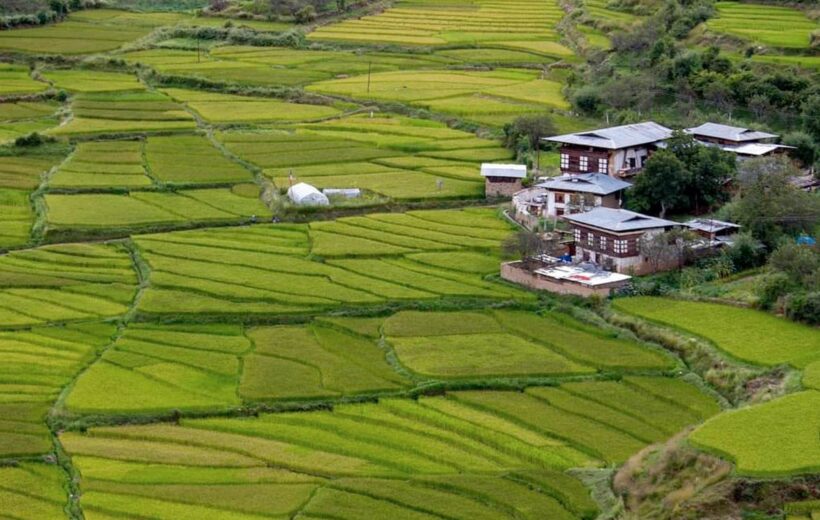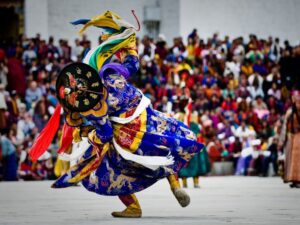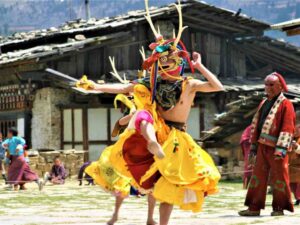Overview
This 8-day journey reveals Bhutan's cultural richness, from Thimphu to the historic sites of Punakha and Paro. Visit monasteries, hike to Tiger's Nest, and explore the scenic Haa Valley. This tour provides a balanced mix of sightseeing, cultural immersion, and relaxation, perfect for experiencing Bhutan's timeless beauty.
Included/Excluded
- The Bhutan SDF
- All accommodations
- Meals and mineral water
- A licensed English-speaking guide
- A driver and vehicle
- Air fare
- A visa fee of US $40
- Alcohol
- Gifts/Souvenirs
- Travel insurance and personal bills
- Museums & Monument Fees
Tour Plan
Day 1: Arrival in Paro & Transfer to Thimphu (54 km, 1-hour drive)
Upon arrival in Paro, you’ll be met by your guide and transferred to Thimphu. Begin your exploration with a visit to the towering Buddha Dordenma statue at Kuensel Phodrang, offering sweeping views of Thimphu Valley. Explore the local Craft Bazaar before visiting the Takin Preserve to see Bhutan’s national animal. Overnight in Thimphu.
Day 2: Thimphu Sightseeing
Spend the day exploring Thimphu, starting with a visit to the Gagyel Lhundrup Weaving Centre to observe traditional textile craftsmanship. Visit the Institute for Zorig Chusum to see students learning Bhutan’s 13 traditional arts and crafts, and later explore the Royal Textile Museum. In the afternoon, visit Tashichhoe Dzong, a historic fortress that houses government offices and the King’s throne room. Overnight in Thimphu.
Day 3: Drive to Punakha via Dochula Pass (71 km, 2 ½ hours)
Drive to Punakha, crossing the stunning Dochula Pass, where 108 chortens stand in honor of Bhutan’s King. Continue to Punakha, visiting the renowned Chhimi Lhakhang, also known as the "Fertility Temple," before exploring the grand Punakha Dzong. Overnight in Punakha.
Day 4: Punakha Short Hike & Sightseeing
Begin the day with a hike to Khamsum Yulley Namgyal Chorten, offering panoramic views of the Mo Chhu River. Continue your exploration of the peaceful Limbukha Village, known for its tranquil setting and red rice cultivation. Overnight in Punakha.
Day 5: Return to Paro (135 km, 4 hours) & Paro Festival
Return to Paro, stopping at the Tamchog Lhakhang and its ancient iron chain bridge. In Paro, visit Paro Dzong and, if timed with a festival, enjoy the colorful celebrations. Overnight in Paro.
Day 6: Hike to Taktsang Monastery (Tiger’s Nest)
Spend the day hiking to the iconic Taktsang Monastery, also known as Tiger’s Nest. After descending, visit Drukgyel Dzong and explore a traditional Bhutanese farmhouse to learn about rural life. Overnight in Paro.
Day 7: Day Trip to Haa Valley
Take a scenic drive to Haa Valley via Chele-la Pass, the highest motorable road in Bhutan. Visit Haa Dzong and the twin temples of Lhakhang Karpo and Lhakhang Nagpo. Return to Paro in the evening. Overnight in Paro.
Day 8: Departure from Paro
After breakfast, transfer to Paro Airport for your departure, concluding your unforgettable Bhutan adventure.
Tour Map
Frequently Asked Questions
Bhutan is a year-round destination. There are four seasons: summer (June to August), autumn (September to November), winter (December to February) and spring (March to May). But because of the range of altitudes in the country, and the influence of the north Indian monsoons, the climate is incredibly varied.
In the south, the humid, subtropical climate is fairly consistent year-round, with temperatures between 15oC and 30oC. Central Bhutan, with its temperate forests, has a more seasonal climate, with warm summers and cool, dry winters. The northern regions are much colder during winter. Because of the high altitude, mountain peaks are snowy year-round and the lower reaches remain cool in summer.
In summer, the Indian monsoon season runs from late June or July to late September, mostly affecting the southern regions. Most farming activities take place in the summer, when crops thrive in verdant landscapes.
Autumn, from late September or early October to late November, follows the rainy season. It is characterised by bright, sunny days and some early snowfall at higher elevations. It’s the season of feasts and festivals as farmers reap the fruits of their work.
From late November until March, the crisp, clear and sunny winter sets in, with frost throughout much of the country and snowfall common above elevations of 3,000 metres. The winter northeast monsoon brings gale-force winds at the highest altitudes through high mountain passes, giving Bhutan the name Drukyul, which means Land of the Thunder Dragon in Dzongkha (Bhutan’s national language).
Bhutan’s generally dry spring starts in early March and lasts until mid-April. It is a botanist’s delight, with nature in full bloom. Summer weather commences in mid-April with occasional showers and continues to late June.
Visitors of all nationalities, except those from India, require a visa before entering Bhutan. For all visitors, except those from Bangladesh and the Maldives, this visa must be applied for and approved in advance of travel. Visitors from Bangladesh and the Maldives also require a visa, but this can be applied for and approved either in advance of travel or upon arrival in Bhutan.
Visitors from India are able to apply for a permit but are required to hold an Indian passport or an Indian voter ID card. For Indian nationals under the age of 18, a passport or a birth certificate can be used to enter and they must be accompanied by a legal guardian.
Nationals from Switzerland and Thailand holding diplomatic or government-official passports are eligible for a visa at their port of entry.
A correctly input visa application can take up to five days to process.
There is a one-off fee of US$40 for the processing of your application. This is payable at the same time as your Sustainable Development Fee (SDF), as part of the process of submitting your visa application.
All treks must be undertaken with an accredited tour operator or guide. Your tour operator will assist you with all the necessary logistics and safety precautions.
Please contact our hosts for the Department of Tourism’s list of approved tourism services.
The Sustainable Development Fee (SDF) is a daily levy paid by visitors to support Bhutan’s development. Since the kingdom first opened its doors in 1974, guests have played a critical role in our country’s growth.
The SDF is collected by the national exchequer and funds are allocated to various projects that create long-term, sustainable opportunities for the Bhutanese people, through free healthcare, education and training, upskilling the tourism and hospitality industry, improved infrastructure, environmental preservation and conservation, cultural preservation programmes and initiatives that support local businesses and economies. The SDF is also a vital means of maintaining the exceptional forest cover and carbon-neutrality for which our small nation is world-renowned and globally critical. The SDF also helps us to ensure that we can continue to offer guests tranquillity and an intimate experience.
The SDF is USD 100 per night for adults from all countries except for India. Children aged between 6 years and who have not yet turned 12 are eligible to pay USD 50 per night. Children who have not yet turned 6 years old do not have to pay any SDF.
The SDF for Indian nationals (showing a valid Indian passport or Voter ID card) is Nu. 1,200 (or the equivalent amount in Indian rupees) per person, per night. Children aged between 6 years and who have not yet turned 12 are eligible to pay Nu./INR 600 per night. Children who have not yet turned 6 years old do not have to pay any SDF.
SIM cards can be purchased from the Paro International Airport’s visitor information centre on arrival, or from branch offices of Bhutan Telecom and TashiCell, or from authorised agents in towns.
There are no rules about what visitors should wear. However if you are planning to visit places of religious significance, respectful smart-casual clothing that covers your body from shoulders to knees is appropriate and appreciated.
Yes, permits are required to enter National Parks in Bhutan. However the process can be done online and the permit should be issued quickly. Please visit this link for more information: https://docs.google.com/forms/d/e/1FAIpQLScM4k5SPaGI_GnV6NJuQHstpS5ai9G4wOlpLSq0fsy73EZK7A/viewform
While most monuments in Bhutan are free, some are chargeable. For the full list of monument fees, please click here for more information. Children below 18 years will have a 50% concession and children aged five years and below will be exempted. Most monuments are open from 9am – 5pm each day. In June 2023 it was announced that foreign visitors can now visit monuments whenever they are open to the general public, without any restrictions.
















